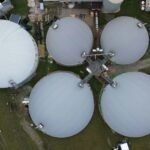Imagine waking up every morning at 5:00 a.m. to the relentless roar of a motorway just metres from your window. Experiencing such high-intensity noise is not an isolated case: millions of people live exposed to environmental noise levels exceeding those recommended by the World Health Organization (WHO). For many, constant environmental noise is not just an annoyance or unpleasant auditory sensation, but a silent threat that undermines health day by day.
What do we mean by noise and how is it measured in decibels?
If you compare the sound of thunder with that of a whistle, you will notice that while thunder has a large amplitude (it is loud) and a low frequency (it sounds deep), the whistle has a smaller amplitude and a higher frequency (it sounds sharp). This is how sound works, a vibration travelling through air or another medium. To determine the characteristics and level of environmental noise, you must consider:
- Amplitude: Amplitude indicates the intensity or strength of a wave, such as the volume of a sound or the brightness of light. In sound, it determines how loud or soft a noise is, while in light it relates to its intensity, i.e., whether it is bright or dim. This strength is measured in decibels (dB) to indicate the volume of the sound. Bear in mind that the decibel scale is logarithmic, meaning a small increase in decibels represents a large increase in sound intensity.
- Frequency: Determines whether the tone of the sound is low or high. Frequency is expressed in hertz (Hz) and represents the number of cycles a wave completes in one second. In sound, it determines the pitch: high frequencies produce high-pitched sounds, and low frequencies produce low-pitched sounds.
- Wavelength: Wavelength, symbolised by the Greek letter lambda (λ), measures the distance between two consecutive equivalent points on a wave, usually in metres or fractions thereof. Frequency and wavelength are inversely related: the higher the frequency, the shorter the wavelength, and vice versa. For example, high-pitched sounds have shorter wavelengths than low-pitched sounds.
- Relationship between frequency and wavelength: The speed at which a wave propagates is calculated by multiplying its frequency by its wavelength (v = f × λ).

Graph showing the relationship between frequency and wavelength – Source: Techplayon.com
Explanation: Imagine a wave in water. The amplitude is the height from the lowest point to the crest of the wave. The frequency represents how many waves pass a fixed point per minute. And the wavelength is the distance between two consecutive crests.
Basic definition of noise
Noise occurs when an unwanted or unpleasant ambient sound interferes with our daily activities. Technically, it is the presence in the environment of noises or vibrations, regardless of origin, that cause discomfort, risks or harm to people and their activities, as well as significant effects on the environment.
Decibel scale and its meaning
The decibel scale (dB) is the most effective way to measure noise intensity in the environment, as it represents changes in acoustic power according to human perception in different contexts. The decibel scale converts into data the vast variety of noises we are exposed to and the sound intensities at which they are emitted.
Air Quality Innovation in Just 1 Click
Stay informed about the air you breathe!
Subscribe to our newsletter to receive the latest updates on environmental monitoring technology, air quality studies, and more.
Just as our ears do not respond linearly to changes in noise intensity, the decibel scale is estimated logarithmically. This means a few decibels can represent a significant increase in environmental noise level. Noise rising from 50 to 60 dB is not just a simple volume increase but is perceived by the human ear as twice as loud. Prolonged exposure to sounds exceeding 85 dB can cause irreversible hearing damage.
Basic equipment for recording decibels (portable sound level meters)
To measure environmental noise accurately and reliably, a portable sound level meter is the best option. It is a device specifically designed to measure noise with high precision. This is thanks to its professional microphone, noise filters and certified calibration. It is the ideal solution for urban noise pollution studies, environmental measurements and compliance with current noise regulations.

Sound level meter device connected to a laptop for urban noise measurements – Photo by Martí Petit – Source: Barcelona.cat – CC License
Types of noise and their characteristic sources
Noise is an urban sound pollution agent with adverse effects on both human health and ecosystem integrity. Its mitigation requires precise identification of the sources responsible for noise emissions such as industrial activities and machinery use.
Traffic noise and decibels during rush hour
Road traffic represents the main source of noise in urban and peri-urban environments. This environmental noise generation is due to a combination of factors: vehicle density and flow, physical characteristics of the road (asphalt type and surface condition), interaction between tyres and pavement, and vehicle speed. Additionally, phenomena such as air turbulence caused by large vehicles and driver behaviour in congestion (accelerations, braking and horn use) significantly increase urban noise pollution levels.
During rush hours, noise from urban traffic ranges between 85 and 90 dB (levels similar to a powerful vacuum cleaner or a loud conversation). To avoid health damage caused by prolonged exposure to noise above 90 dB, many cities adopt measures to mitigate traffic noise impact by installing acoustic barriers, using sound-absorbing asphalt and defining low emission zones (LEZs).
Industrial noise: factories, plants and heavy machinery
Industrial areas and the use of heavy machinery such as in port activities are significant sources of environmental noise. Generally, it is more intense and constant due to the multiplicity of simultaneous production processes and the size of the infrastructures involved. Industrial noise negatively affects the quality of life of surrounding communities, disrupts biodiversity in terrestrial and aquatic ecosystems, and poses a critical occupational hazard for workers exposed continuously.
Sound pressure limits from industrial noise often exceed those considered safe for human health in prolonged exposure situations.
Construction and building noise
Construction activities in urban areas are a significant source of environmental noise, with direct impacts on health and wellbeing of citizens. The main acoustic emissions come from transport and handling of materials, demolition, drilling, metal cutting and operation of powerful equipment.
Prolonged exposure to these noise levels from construction in urban environments can cause discomfort, stress and adverse effects on the physical and mental health of nearby residents and construction workers. Noise levels range from 77.8 dBA (A-weighted decibels) for a backhoe to 96.9 dBA for a bulldozer.
Domestic noise and acoustic microbiomes
Domestic noise refers to undesired sounds perceived inside the home and is likewise a source of noise pollution affecting people and altering the residential environment. Although this sound may come from external sources such as traffic, it can also be caused by internal factors like household appliances, conversations or movements and activities inside the dwelling.
The set of physical properties of sound (volume, frequency and timbre) that produce noise in the home define the unique sound characteristics of each domestic environment or “acoustic microbiome”. This is reflected in the way our brain filters and tolerates home sounds according to context, expectations and previous experiences. Thus, in a balanced acoustic microbiome, soft or familiar sounds predominate, favouring wellbeing and health of residents. Whereas an acoustic microbiome with loud or high-frequency environmental noises is the ideal setting for discomfort, negative emotional reactions, difficulties in concentration and even anxiety.
Environmental noise levels: thresholds and practical standards
The lowest threshold of human hearing corresponds to 0 dB, while the highest—where noise causes pain—is considered to be at levels approaching 130 dB. Environmental noise limits are established based on location, with hospitals and school zones having stricter noise limits than industrial areas.
To estimate urban noise pollution, environmental noise limits are set according to land use, and acoustic quality objectives are estimated according to the competent authority that establishes and reviews the current regulations.
The most commonly used environmental noise limit indicator is the equivalent continuous weighted sound pressure level (LAeq), which measures and analyses noise levels from different sources over a specific time period.
Acoustic planning also uses indices: Lden (day-evening-night level) and Ln (night level) to assess compliance with the established acoustic zoning regulations. Likewise, acoustic quality—between 55-65 dB (day) and 45-55 dB (night)—is verified by the annual average; it estimates the noise indices Ln (day), Lt (evening), and Ln (night) to ensure daily values are respected and that their limits do not exceed 3 dBA.
Recommended decibel values in residential, commercial and industrial areas
Noise limits set in residential areas depend on local regulations, but generally range between 50 and 60 dBA during the day and between 45 and 55 dBA at night. The World Health Organization (WHO) states that noise limits should not exceed 53 dBA on average during the day and remain below 45 dBA at night to avoid physical and mental health damage caused by environmental noise.
In commercial areas, permissible limits range between 65 dBA during the day and 55 dBA at night. By contrast, industrial areas experience the highest environmental noise levels, with a daytime limit of 70 dBA and a night-time limit of 60 dBA. In areas where residential and industrial uses overlap, intermediate limits are set to protect the health and wellbeing of nearby residents.
Interpretation of strategic noise maps (SNMs)
Strategic noise maps (SNMs) are an essential tool for assessing and managing environmental noise, and are mandatory under the Directive 2002/49/EC. SNMs are used for major infrastructures such as roads, railways, airports and urban agglomerations. By identifying the most affected areas, using the Lden and Ln indices, they enable a homogeneous evaluation, estimate acoustic impact, and guide corrective decisions in spatial planning.

Acoustic barriers help reduce environmental noise impact such as traffic noise
Tools and technology for advanced noise monitoring
Environmental noise monitoring has made remarkable progress thanks to the incorporation of new technologies and digital tools such as noise management software. Today, noise control is not only based on high-precision measuring devices but also on advanced computer systems capable of processing and analysing large volumes of real-time data.
Thanks to this evolution, it is possible to identify noise patterns, assess their impact on health and wellbeing, establish noise prediction models, and implement more effective strategies to reduce noise pollution in both urban and industrial environments.
Fixed monitoring stations vs. sensor networks
Fixed environmental noise monitoring stations are usually located at strategic points where noise is a recurring problem, such as high traffic areas, industrial zones or places with large crowds. They provide stable and reliable measurements over time, allowing analysis of noise trends and their impact on public health.
Distributed sensor networks consist of multiple interconnected sensors that collect real-time data from various locations such as street furniture, poles or even vehicles. This offers a more dynamic and accurate view of urban noise pollution.

Kunak AIR Pro air quality station integrating a sound level meter for urban noise control
Cloud platforms and dashboards for real-time analysis
The analysis of environmental noise data has evolved enormously with the integration of cloud platforms and interactive dashboards. Together, they facilitate real-time noise monitoring and support informed decision-making based on collected data.
Cloud platforms are digital tools prized for their secure and accessible capacity to store large volumes of data, allowing sensors distributed across the study area to send continuous information. Thanks to cloud computing systems based on algorithms, data is processed instantly, optimising analysis and report generation without the need for complex local infrastructure.
Meanwhile, dashboards transform this data into intuitive visualisations showing noise patterns, trends and alerts in easy-to-understand graphical interfaces. These panels enable public authorities, companies and noise pollution experts to access precise and reliable information from which to respond swiftly by activating noise control or mitigation measures.
Predictive noise models based on AI and machine learning
Predictive noise models that use artificial intelligence (AI) and machine learning represent a significant advance in urban acoustic planning and management. These systems apply advanced algorithms to process and analyse large volumes of data collected by sensors distributed in acoustic monitoring stations.
Thanks to this processing capacity, models can identify complex patterns and temporal trends that would not be apparent with traditional methods. For example, they can correlate fluctuations in noise levels with factors such as vehicle traffic intensity and type, meteorological conditions (wind, temperature, humidity), working hours or specific industrial activities.
This technology allows anticipation of noise peaks and the generation of predictive maps that help urban planners and environmental managers make informed and proactive decisions. Preventive measures can thus be implemented, such as traffic management adjustments or activation of protocols in sensitive areas before disturbances or negative impacts on public health occur.
Furthermore, the integration of historical data with real-time sensors facilitates continuous updating of models, improving their accuracy and adaptability to changes in the urban environment. This makes AI-based predictive models a key tool for achieving more efficient and sustainable acoustic management.
Mitigation strategies: from acoustic barriers to building insulation
Mitigation strategies for environmental noise in both urban environments and buildings range from the installation of panels and acoustic barriers to the implementation of advanced acoustic insulation systems within the structure of buildings themselves. Although different in application, both options aim to reduce sound transmission and improve residents’ quality of life.
Design and placement of acoustic barriers on roads and industrial areas
Panels and acoustic barriers are solutions designed to obstruct noise propagation. They act as physical obstacles that absorb, block or diffract sound waves. This function is especially useful in environments with regular noise, such as roads and industrial zones.
Materials and insulation techniques for façades and roofs
Applying acoustic insulation in buildings involves the use of materials and construction techniques that prevent sound transmission from outside and also between different internal areas of the building. To achieve this, sound-absorbing materials (wool, fiberglass, and plasterboard panels) are used to absorb sound, prevent reverberation and echo, and generally optimise wellbeing inside buildings. This strategy is reinforced by acoustic barriers on walls and windows, including the massive noise-blocking effect of dense walls made from concrete and plasterboard, and double or triple-glazed glass. Air chambers are also employed in the interior spaces between structures to decouple or dampen noise and vibration transmission.
Evaluation of interior acoustic comfort in homes and offices
To assess acoustic comfort in indoor spaces such as homes and offices, various physical and perceptual parameters are analysed to determine the acoustic quality of these environments.
Evaluation is based on:
- Sound pressure level: indicates the noise level and its suitability for the activities conducted in that indoor space.
- Reverberation time: estimates how long it takes for noise to decrease in intensity.
- Acoustic insulation: assesses structural elements and their effectiveness in preventing noise transmission.
- Speech clarity: essential for estimating the comprehension of conversations in indoor spaces such as offices and meeting rooms.
- Background and impact noise: measures background noise (usually constant) and impact noise, caused by specific events such as knocks and vibrations transmitted from other parts of the building.
Industrial noise and its impact on health and productivity
Noise generated during industrial activities, mainly by manufacturing processes and the use of heavy machinery, is a critical risk factor affecting both the health of workers and the efficiency and ultimately the productivity of companies. Therefore, controlling industrial and machinery noise is not only a means to achieve acoustic comfort but also to ensure a safe and healthy work environment.
Effects of continuous noise on operators and plant workers
Operators and workers in industrial plants, exposed to prolonged noise, suffer impacts on their physical and mental health, including hearing loss, cardiovascular disorders, psychological problems, and an increased risk of accidents due to communication difficulties caused by constant noise.
Occupational regulations: maximum permissible noise limits in factories
While occupational health regulations set maximum noise exposure limits to protect workers’ health, generally preventive measures should be established from 80 dB, the level at which hearing damage and health issues can begin. Workers must also have individual hearing protection equipment to reduce noise levels exceeding these limits.
Companies must carry out regular assessments to monitor the workplace environment and identify noise sources and their levels; this data is essential for establishing appropriate measures to reduce industrial noise.
Relationship between auditory fatigue, stress and business productivity
Continuous exposure to industrial noise not only affects workers’ health but also alters their productivity, which negatively impacts business performance.
Auditory fatigue caused by constant industrial noise leads to tiredness, a major factor in work-related stress experienced by many workers, which is often the root of psychological disorders.
Controlling industrial noise and improving acoustic comfort is essential to protect workers’ health, comply with occupational regulations, and optimise business productivity.
The integration of technical solutions, use of protective equipment, and employee training in noise safety are key strategies to mitigate the negative effects of industrial noise.
Comprehensive noise management software in municipal and industrial plans
Nowadays, having noise management software places an essential tool in the hands of municipal administrations, urban managers, and industry leaders for control, monitoring and informed decision-making regarding the acoustic impact caused by environmental noise. These platforms, equipped with advanced technologies and adaptable functions to sector requirements, enable proactive and efficient real-time noise management.
Key features: alerts, reports and geolocation
Noise management software solutions, notable for their ability to continuously and accurately monitor noise levels, optimise environmental management and regulatory compliance by providing:
- Real-time alerts: detecting and notifying immediately when noise levels exceed limits, enabling prompt responses to reduce health and environmental risks.
- Automated reports: detailed and specific to the installation, facilitating regulatory compliance and internal control.
- Geolocation: accurately mapping measurement devices to translate noise levels onto digital maps, facilitating the identification of critical points and times, and supporting informed decision-making.
- Intuitive interface: accessible platforms that ease data interpretation and informed action.
Integration with environmental systems (air, water and noise)
Noise management software integrates measurement of other environmental parameters (air and water), expanding the scope and effectiveness of environmental control systems. This makes such comprehensive solutions a key tool for cities and industries to efficiently manage noise and promote improved acoustic comfort in line with current regulatory requirements.
FAQ (Frequently Asked Questions) about noise
What is the difference between soundproofing and acoustic insulation?
While soundproofing and acoustic insulation are closely related concepts regarding environmental noise, they differ in that:
- Acoustic insulation: reduces sound wave energy by interposing high-density physical acoustic barriers between two spaces, preventing external noise from entering or sound transmission between interior spaces in homes, offices and commercial premises.
- Soundproofing: aims to acoustically condition indoor spaces so that sound cannot enter or exit. It relies not only on construction systems but also on insulating and absorbing materials such as those required in cinemas, music rooms and recording studios to achieve maximum sound control.
How are strategic noise maps (SNMs) created?
The preparation of strategic noise maps (SNMs) is a technical and regulatory process that allows the assessment of environmental noise exposure in urban, industrial or infrastructure areas, integrating data on noise levels, noise sources and demographic data of affected populations.
They are produced from collected data on noise sources, environmental characteristics and resident populations. Mathematical models and specialised software simulate sound propagation in the estimated area. From this, noise level maps (usually at 4 metres above ground level) and exposure maps identifying buildings and populations affected by environmental noise are generated.
Is it cost-effective to install acoustic barriers in urban environments?
Installing acoustic barriers in urban environments is a cost-effective and efficient solution to mitigate urban noise pollution, especially in areas affected by noise from road traffic, construction or industrial infrastructure. Their cost-effectiveness is assessed both economically and in terms of social and environmental benefits. They can reduce noise levels in residential and sensitive areas by up to 32 dB, improving acoustic comfort and quality of life for affected populations. Additionally, their use facilitates compliance with noise regulations in urban zones.
What software is best suited for real-time noise management?
Noise control solutions based on noise management software enable precise real-time monitoring, whilst also helping ensure regulatory compliance and improving environmental management.
Key functionalities include:
- Real-time alerts notifying when noise levels exceed limits;
- Automatic reports facilitating regulatory compliance;
- Geolocation mapping noise levels for better identification of critical areas; and
- an intuitive interface that optimises data interpretation.
Moreover, these systems integrate measurement of other environmental parameters such as air and water quality, offering a comprehensive solution for environmental management in cities and industries.
Conclusion: towards quieter and healthier environments
Environmental noise is a global challenge, but the combination of social awareness and technological advances provides a real opportunity to transform the sound environment in which we live.
Measuring and mitigating environmental noise is not only a matter of comfort but an urgent necessity for public health and wellbeing.
The integration of smart sensors, real-time monitoring networks and advanced analysis software has transformed how we address noise pollution. These tools enable precise noise source detection, impact anticipation and the implementation of effective reduction strategies. It is not just about compliance, but about progressing towards more liveable cities, more responsible industries and healthier communities.
The challenge is underway: investing in sustainable acoustic infrastructures, adopting urban noise reduction policies and encouraging the use of innovative technologies to manage sound efficiently.
A future with less noise, and therefore greater wellbeing, is possible—and the key lies in harnessing technology’s power to make silence an essential element of our quality of life.




